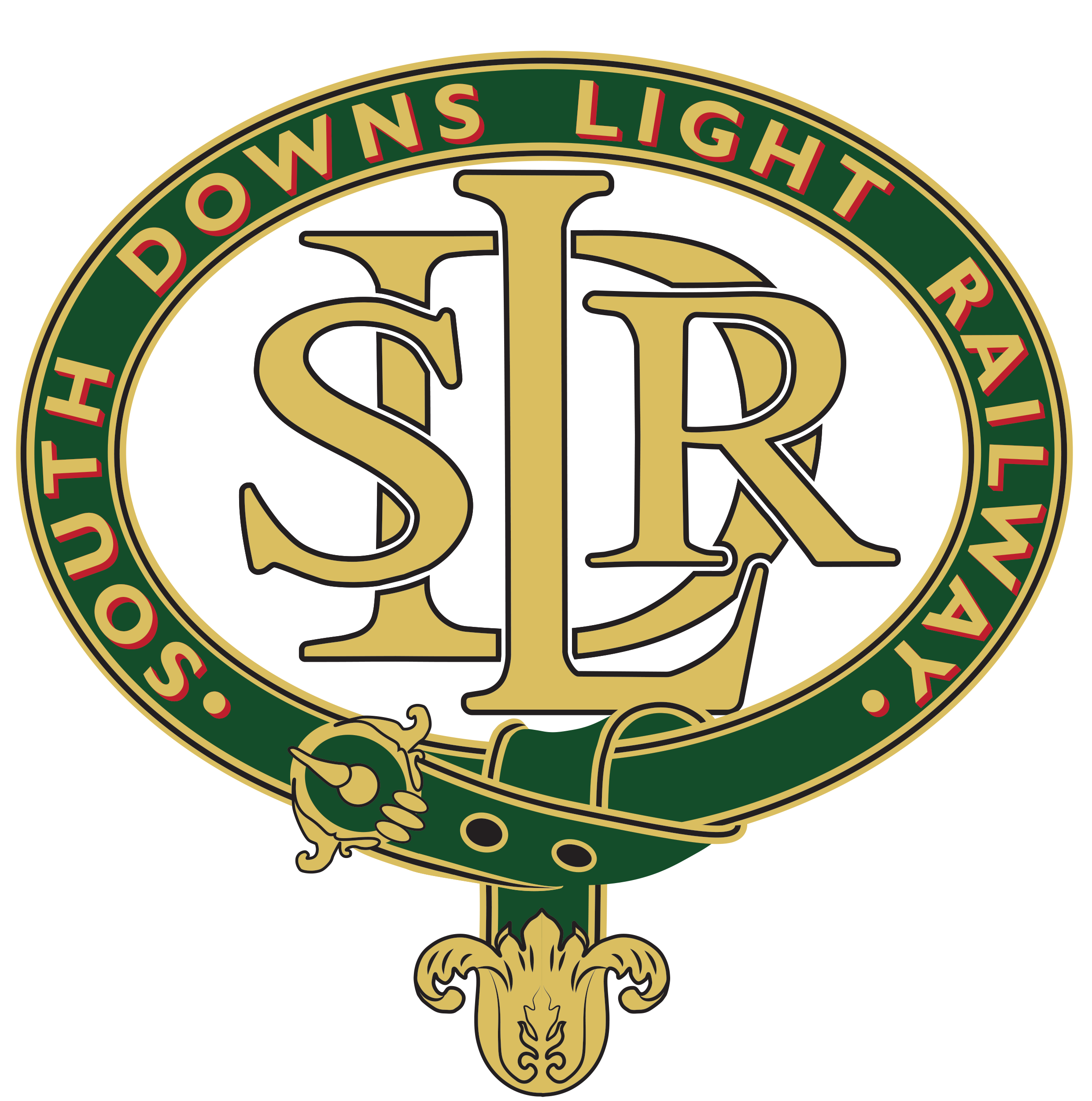No. 1 – Alice
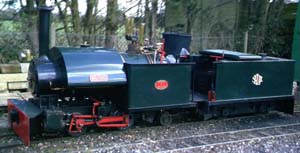
‘Alice’ is a 10 ¼in. gauge model of the small 2ft gauge Bagnall locomotives supplied to many quarries, factories and construction companies in the early 20th century. She is built to a scale of 5 inches to the foot, producing a very powerful locomotive of just under half full size.
Built by Giles Favell, designed by the Rev. Brian Favell, ‘Alice’ took five and a half years to build, and was completed in 2001. It was named after Alice Favell, the builders’ mother (who had to put up with ‘flipping railways’ all her life so Giles said).
‘Alice’ became the first narrow gauge styled engine at The South Downs Light Railway, and was considered the ‘big’ engine before the Exmoor’s arrived. Her cylinders are 2 7/8” bore, 3 ¾” stroke. She has a marine type fire-box, which steams very well and is very easy to manage.
As two people are able to sit side by side on her tender, ‘Alice’ is frequently used for driver training.
‘Alice’ had an overhaul in 2020 and was also repainted into a lined green livery by Mick Blackburn.
No. 197 – Agapanthus

This locomotive was built for Lord Braybrooke of Audley End in 1997 by David Curwen (Chief Mechanical Engineer of the Talyllyn Railway for its first season of operation in preservation during 1951). It operated upon the Audley End Railway as Barbara Curwen – David Curwen’s wife, until 2014 when it was withdrawn for a lengthy overhaul, including a new firebox.
After the passing of Lord Braybrooke in 2017, a decision was taken to dispose of a number of the Railway’s smaller locomotives, including Barbara Curwen as their volume of traffic demanded longer trains than those locomotives were generally able to handle. As a result an auction was held on 12th March 2019 and in anticipation of this Alan Eatwell asked whether a home could be found at Pulborough for the locomotive should he successfully bid for it. The SDLRS were pleased to say yes, Alan joined as a member and having become the successful bidder the locomotive was delivered to Pulborough on 20th March 2019, where it will be known as Agapanthus – an African Lily as colleagues at the garden centre will confirm.
The locomotive is based on the three Hunslet 0-4-0 Saddle Tanks (Linda, Blanche & Charles) supplied new to the 1ʹ10¾ʺ gauge Penrhyn Quarry Railway between 1883 & 1893. After the closure of that system in 1962 Linda & Blanche were acquired by the Ffestiniog Railway and in 1970 they were modified to a 2-4-0 wheel arrangement by the addition of a leading pony truck. It is in this form that Agapanthus was loosely modelled, though with a further trailing axle as a 2-4-2.
No. 319 – Pulborough
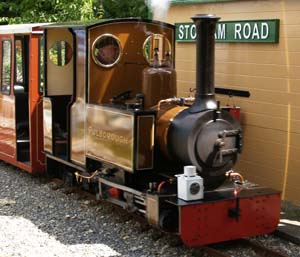
This is an 0-4-2 freelance narrow gauge tank locomotive built by the Exmoor Steam Railway for the South Downs Light Railway Society in 2004. It was designed to cope with the tight radiuses and narrow clearances on the Railway whilst still being capable of handling heavy trains.
The engine is owned jointly by the Society and a group of members.
The colour scheme and name are those of the London Brighton and South Coast Railway which built the line to Pulborough and whose D3 class locomotive carried the same name.
No. 334 – Peggy
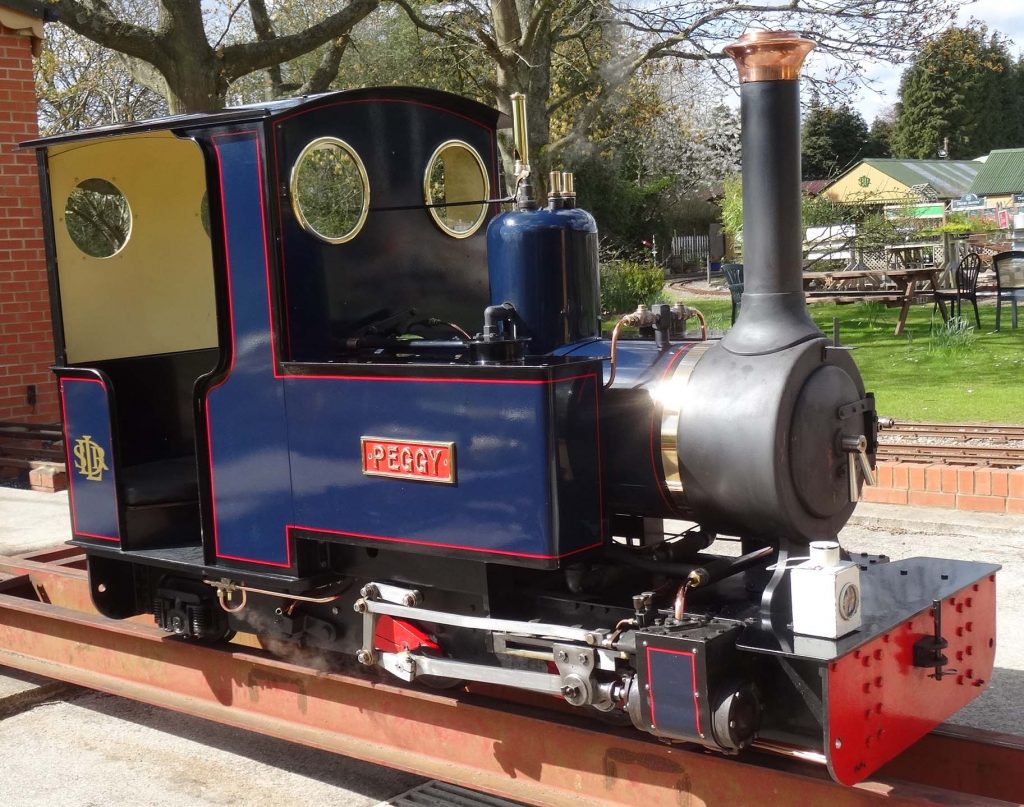
Peggy was built by the Exmoor Steam Railway of Bratton Fleming, Barnstaple, North Devon in 2007 and came to the South Downs Light Railway in December of that year. Her works number is 334.
She is a sister engine to 319 Pulborough although there are detail differences between them.
She is a freelance 0-4-2 narrow gauge tank engine built in the Exmoor Steam Railway style. Her cylinders are 3.5″ x 5″ and the driving wheels are 9.25″ in diameter. The working boiler pressure is 120lbs psi. She is approximately one-fifth full size.
In running order Peggy weighs 1275kgs and is more than capable of hauling our heaviest trains.
Peggy carries the Royal Blue livery of old Great Eastern Railway. She was owned by a group of members called the Peggy Owners Group (POGS for short) and is named after the mother-in-law of the principal member of the group who recalls seeing the station pilot at Liverpool Street Station fully lined in GER livery. Peggy is now a Society owned loco.
No. 21C1 – Channel Packet
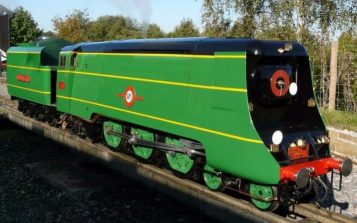
It was just prior to the Second World War that Bulleid began to design and build steam locomotives for the Southern Railway. This followed a period in which scant regard was paid to the development of steam traction on a system undergoing electrification.
Oliver Vaughan Snell Bullied was appointed CME to the Southern Railway in June 1937 and was encouraged by Robert Holland-Martin, the Chairman of the Southern to spend time and money on the much neglected steam locomotive. His design was specifically for an express passenger locomotive, but as the prospect of war seemed ever closer he modified his description and called his new ideas mixed traffic engines.
The first of what was to be called Merchant Navy Class locomotives was built at Eastleigh works as order 1068 and it incorporated many new and novel features including, chain driven valve gear, American Boxpok type wheels and a boiler designed to operate at 280lbs/sq.in.,with super heat temperatures in the region of 400°C. Its outer casing was a design first although modifications and improvements were made throughout its life. It must be stated that many of the ideas were unproven since Eastleigh, along with other railway works at this time, was engaged in war work, manufacturing equipment for the armed forces in the fight against Germany. So the production of the first ten locomotives went ahead without a prototype being constructed and described as useful fast freight locomotives.
‘Channel Packet’ rolled off the production line in the early part of 1941 and its first mainline test run was to Winchester on 18th February 1941 and then to Bournemouth the following day. The Minister of Transport of the time, Rt.Hon. J.T.C. Moore-Brabazon named the locomotive, on the 10th March 1941, in the yard at Eastleigh Works. Throughout the 1940s, in order to eliminate problems with combustion gases, modifications were made to the streamlining – removal of the ‘widow’s peak’, the fitting of smoke deflectors and the inverted horseshoe plate was replaced by a standard circular type.
Before construction of the ‘Channel Packet’ that you see before you took place, extensive research was carried out to make the locomotive as accurate as seemingly possible, and it was decided that the engine would be built in its 1945 guise, and to a scale of 2¼″ to 1ft.
Work began at Jesse Moody’s workshop on 11th February 2010 with no specific finishing date in mind so it is not surprising that Jesse completed other jobs, the construction of new first class carriages for Lakeside and modifications to Chris English’s ‘Black Five’, whilst manufacturing components for 21C1.
A major departure from the original was the design for the inside valve gear. Moving away completely from the Bulleid’s chain drive, a valve gear based on an American Southern Marshall type was designed by Barry Eden who, to make certain that his ideas would work, designed and built a full sized replica before helping with the construction of the one fitted to this locomotive. Although this engine has three cylinders as per the original, the valve gear to the middle cylinder is unique, and is not to be found on any other Merchant Navy locomotive. In just over a year from the start of construction, ‘Channel Packet’ was, on 5th May 2011, run on compressed air, and a further four months on, on 20th September 2011 she underwent a steam test for the boiler certificate which she passed with flying colours, a testament to the engineering skill of Jesse Moody. It is doubtful whether another 10¼″ gauge locomotive could have been built to such a demanding timescale as this.
It was in July 2025 that Channel Packet was purchased by South Downs Light Railway and one of it’s members and moved to our railway.
21C1 is currently undergoing an overhaul.
No. 27 – The Railway Mission
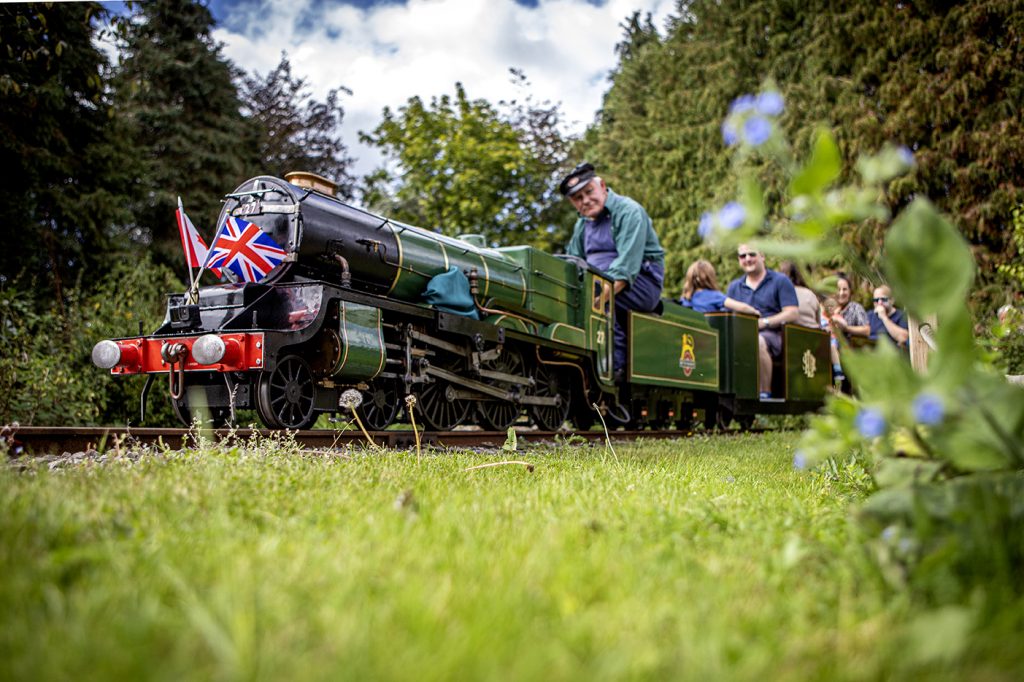
Construction of 27 started before the war by G&S Light Engineering but was not completed until 1947 by Ernest Dove who purchased the frames from G&S. Dove sold the engine new in 1947 to William Botterill of Botterill Miniature Railways. It ran for a time on Margate pier, moving in about 1950 to the Cleethorpes Miniature Railway which was 10 1/4″ gauge at that time.
During this early part of her life she was known as “The Queen of Scots” and in about 1951, if not in 1950, was noted carrying a red livery. At the end of the 1953 season “Queen of Scots” was placed in store following the sale of the Cleethorpes line and its motive power being replaced by battery electrics. The engine was sold to Geoff Hunt of Bristol, a dealer in miniature railway equipment in 1956, later in 1956 “Queen of Scots” was sold to Sam Sunter of Calgary, Alberta. Sam hailed originally from Northumberland and had moved to Calgary, I think, in the 1920’s, he established a 10 1/4″ gauge railway in Bowness Park using a Carland Royal Scot and had purchased Queen of Scots to add to his motive power.
Sam started on a long term rebuild of what became No 27 Isabel (Sam’s wife’s middle name). During this time Sam moved to Victoria on Vancouver Island and established the Victoria Miniature Railway in Cordova Bay. This opened in 1961 using a Canadian built 4-6-4 Isabel coming into service in about 1962. John Lunn (our Permanent Way Manager) was introduced to Sam and the V.M.R in May 1966, one month after arriving in Canada with his brothers and parents. John drove Isabel from May 1966 until just after he started work on Canadian Pacific in 1969. John drove the engine again during the summer holiday of 1969 as Canadian Pacific had laid him off until that September.
The V.M.R closed in 1970-71 and following sale to several different purchasers the engine finished up in Canfield Ohio U.S.A. being stored until purchased by Brian Gent and Peter Bowers and returned to the U.K. on 15th December 2002, where John purchased the loco on 4th May 2012 and it was moved to his home for a long slow overhaul to take place. A new boiler has been made along with new running boards and tender body, of the front bogie only the wheels and axles are original likewise all driving axles and driving axleboxes have been replaced, on replacing the connecting rods John found that the left leading rod was 3/32″ shorter than the corresponding right hand rod, the addition of slop in all the driving boxes plus an off set big end bearing appears to have overcome this problem!!
In 2018, the locomotive moved to South Downs Light Railway where work was continuted and the overhaul completed in 2021. During the Steam Gala in September 2021 the loco was reanmed “The Railway Mission”.
No. 35 – Arthur
‘Arthur’ was built by Jack Hudell in Selby, Yorkshire and was completed in 1982. It is based on a Martin Evans design for a 7¼in. gauge ‘Holmside’ industrial locomotive described in Model Engineer in 1977-78.
This design is broadly based on an 0-6-0 saddle tank locomotive that used to work for the National Coal Board which had outside cylinders and inside Stephenson link valve gear and named ‘Holmside’.
‘Arthur’ is believed to be the only 10¼in. version built to date. It was used by Jack Hudell at several locations including Southsea and at the Royal Victoria Country Park, Southampton.
In 1991 Brian Merrifield purchased ‘Arthur’ for the Poole Park Railway and it was later acquired from Brian in 1998 for ‘The Manor Railway, Ingfield’, as it was then called. Following some minor works it was then moved to Pulborough in 2000 and used regularly until withdrawn in 2003 for overhaul.
35 is currently undergoing an overhaul.
No. 57 – Lion

Over the summer of 2023 a surprise came to light when six unknown 10¼in. gauge engines unexpectedly came up for auction, within this was Lion. Harry Spencer was the winning bidder.
The real Lion of course, is the name given to the Liverpool and Manchester Railway, 0-4-2 Tender locomotive of 1840 Vintage. The real locomotive was designed as a “Luggage Engine”; a term given to what we would later call a goods engine.
She is an enlarged version of the planet type locomotive which replaced Rocket shortly after the Rainhill Trials. The model has Gabb patent valve gear, much like the real deal.
No. 625 – Lilly
This 0-6-0 locomotive was constructed using parts originally intended for a 10¼in. gauge LB&SCR Terrier. It was finished in a Victorian style, featuring a wood-lagged boiler and a flysheet-style cab.
The locomotive was completed during the COVID-19 lockdown, serving as a welcome distraction from the challenges of that time. In 2024, it was acquired by Harry Spencer and Jerry Chivers, who have since renamed it ‘Lilly.’ They hope to have it running for the 2025 season, either as a small shunting engine or pulling part of Jerry Chivers’ goods set.
625 is currently undergoing an overhaul.
No. 721 – Dunalastair
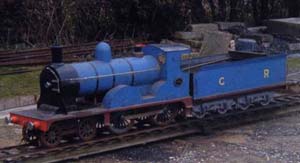
The story goes that three miniature engines were built by the apprentices at the Caledonian loco works in St Rollox, around the time of the late 19th century. The apprentices presumably built them so that they could get to understand how the full size ones worked and were put together. These three locos are still around today. One is in the Glasgow Transport Museum. The second is owned by Drummond Randall and for a time ran at Birchley Light Railway. It is now being overhauled. The third is allegedly the one owned by Paul Cowlin, number 769.
The history of this loco is rather vague and the ‘hows’ and ‘whys’ of the engine ending up in certain places is unknown to both Paul and his son, Tom. If anyone has any additional information about it, it would be great to hear. However, what is known is that the loco, most likely just after the Second World War, had its cylinder and valve gear removed, and conversion had started to change it into an internal combustion engine driven loco. This work was never completed. Weirdly, all the non-painted metal parts that were removed had been chrome plated!
Later on in its life, it came into the hands of the late Matthew Kerr. At this time, Keith Stratton (owner of Ingfield Manor Railway), offered to overhaul the engine for Matthew. Unfortunately, Keith passed away before finishing the overhaul and had only finished work on the tender bogies. The loco then ended up in a garage at Christ’s Hospital School. This is where Paul first saw the loco. He went on to write to Matthew and came to the agreement that he would put the loco back to steam, with Matthew owning 5% of it.
For some time the engine sat at Paul’s work; Horsham police workshops. He made the cylinder block and started work on the crank axle, at the farm workshops. When the new workshop at South Downs Light Railway was built, the loco and bits he had made moved there, where work has stopped on it since. This is due to other projects such as the Scotsman, 5MT, and the Mardyke Brake coach.
Paul still owns 95% of the engine and Matthew’s son, John, is now the owner of the 5%. It has become tradition that John asks how the loco is doing on every Heywood trip that Paul and Tom go on. The loco now rests in the engine shed at Pulborough. Even though no work has been done on it for a few years now, Paul plans to one day finish it off and bring it back to steam. Who knows, one day this may become one of Tom’s projects and he will help bring it back to steam!
721 is currently undergoing an overhaul.
No. 850 – Lord Nelson

850 was built by Jesse Moody in 2006, although she was based on a Carland Greenly Scot dating back to the 50’s. She was built for the Eastleigh Lakeside Steam railway where she worked for many years before moving to Pulborough in May 2025.
850 is currently undergoing an overhaul by Spencer Steam Services.
No. 4433

Built in 1964/65 by David Curwen for Lord Braybrooke’s Audley End miniature railway, it proved to be a very fast and powerful performer and a firm favouritewith Robin, Lord Braybrooke.
This loco was Curwen’s first ‘scale’ model locomotive, although not in fact a true scale copy of a full size GNR Ivatt Atlantic, the loco is in fact essentially a 3 times scaled up version of LBSC’s 31/2in. gauge Maisie’ design.
Interestingly, both this engine and ‘Agapanthus’ share the same boiler design. The Atlantic is currently owned by Nick Collier who has recently moved the loco to Pulborough.
No. 4472 – LNER “Flying Scotsman”

The locomotive was built to 10.5″ gauge in Australia in 1934. It was imported into the UK in the 1950’s by Mr. Bob Hamblin and had spent 20 years, until fairly recently, in a garage in Uppingham. The loco was restored and re-gauged to 10.25″ at the British Engineerium, where Chief Engineer Peter Fagg supervised the contracts and carried out most of the engineering work. The repainting and line was completed by Alan Roberts and Julian McQuillan. It is currently owned by father and son, Paul and Thomas Cowlin.
More information has been gathered, mainly from the August 1953 edition of the Model Engineer: A 5″ and 10.5″ loco was commissioned by Dr. H. S. Bush for his garden in Caulfield, Victoria, Australia. The builder was J.J. Mahony of West Melbourne. The owner’s notes from the time state “both engines are superbly built, and though not adhering strictly to scale, each is a thing of artistic beauty as well as of mechanical skill and symmetry. They have both been, and still are, universally admired and are, of course, capable of hauling passengers.”
The manufacturer’s notes are interesting. An important extract is as follows: “The larger engines is a 2″ scale, 10.5″ gauge ‘Pacific’, following closely the LNER type. As no drawings were available, I had to start from scratch and make my own from some photos in the ‘Wonder Book of Railways’. Then I had to have all the necessary patterns (wheels, cylinders etc.) made, as no parts are procurable out here.”
4472 is currently undergoing an overhaul.
No. 6100
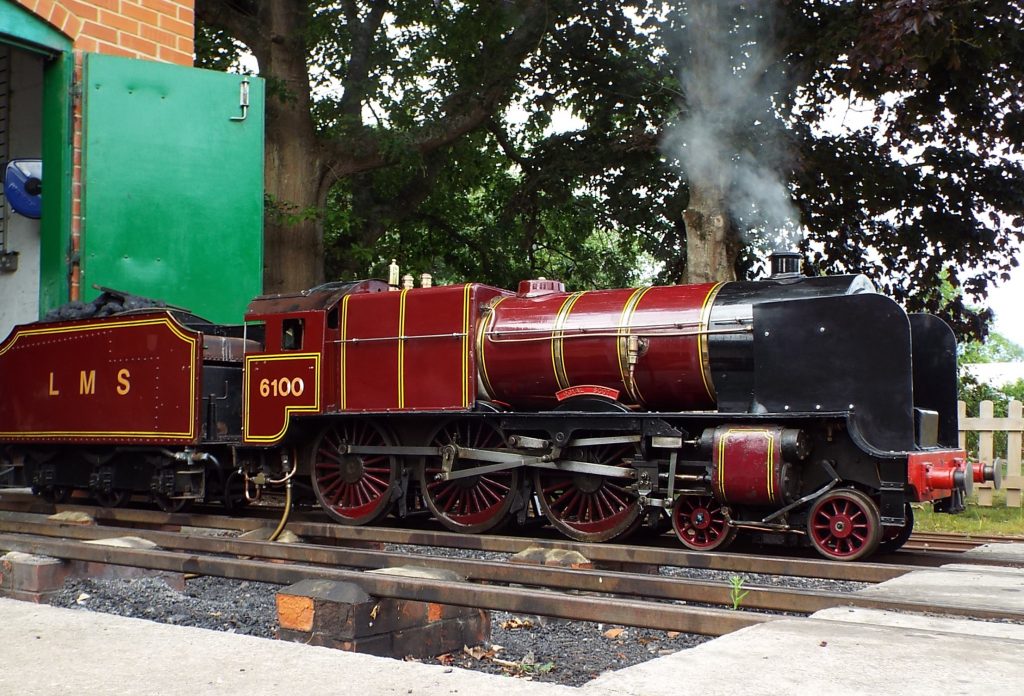
This model is believed to have been built in 1948, by Carland Engineering, one of a number that they built after the Second World War. It was purchased from the family of Arthur Thomson following his death, together with the LMS pacific Locomotive ‘Coronation’, which is also at Pulborough.
It previously ran at Syon Park, Middlesex, from approximately 1993 to 2005, and thereafter at the Eastleigh Lakeside Railway, Southampton from 2007 to 2019. It is currently painted in LMS crimson, has two injectors and a maximum working pressure of 150 p.s.i. which gives it plenty of power.
Since it has been at Pulborough a number of improvements/necessary alterations have been made including new washout plugs, new fusible plug, replaced gauge glasses, ball valves fitted for the two injectors plus a new whistle valve amongst other things.
At some point in the future it is intended to re-paint her in British Railways black livery with appropriate lining.
No. 6220 – Coronation
Ernest Dove was the owner of a successful road haulage firm, but his main interest was model engineering.
He constructed a number of steam locomotives including ‘No.27’ and ‘Coronation’.
‘Coronation’ was the first 10¼in. locomotive that he built, taking approximately 10 years to finish, being completed in 1946.
The loco moved to Christchurch, where it ran for 20 years. In 1978 it moved to the new Railway at Syon Park in Brentford and ran until the line was closed in 2005.
The loco was then bought by A .Thompson, moved to Eastleigh Lakeside steam railway and overhauled in 2007/8 before moving to the SDLR in 2019 where it is now owned by Julian Chivers.
No. 13245 – LMS Mogul

The two-cylinder Class 5-F/4-P 2-6-0 was the first locomotive design credited to Sir William Stanier after he became Chief Mechanical Engineer of the LMS in 1932.
Only 40 were built and were seen all round the Midland Region. They rarely made headlines, being used on duties such as fast freight, parcels, medium goods and local passenger work. Their main ‘excitement’ came with summer specials and holiday expresses.
The model was completed in 1987 by the late Peter Howard for his Downsells Railway near Maidstone in Kent. Prior to the builder’s premature death in 1998, the loco was acquired by Peter Taylor initially to run on the Manor Railway, Ingfield and subsequently on the South Downs Light Railway, Pulborough.
Technical details:-
Boiler – built by Bennett Boilers, Bristol in 1987. Working pressure 100 lb/sq. in.
Cylinders – 3 in. bore x 4¾ in. stroke. Fitted with steam operated drain cocks.
No. 38 – Merlin

Although not seen by the public very often, 0-4-0 Electric ‘Merlin’ has resided at SDLR for around 10 years. Not normally used for passenger services, Merlin is mostly used for P-way trains during the off season at the railway. It can also be seen occasionally shunting in the yard. The loco was built by Roanoke Miniature Engineering. During its operation from 1998 to 2011, Roanoke Engineering built some 65 diesel and steam outline locos. Although not the most elegant looking, they were simple and well built. This made it a firm favourite with commercial operating railways. Jerry Chivers, Tom and Paul Cowlin bought the loco from the society in 2021.
Merlin has had a number of engine changes throughout the years. Originally built with a Honda petrol engine, it was later converted to take a diesel engine. There was nothing but bad luck with the first diesel engine fitted. This was replaced with a second, but both engines had the tendency to blow up. Once it came into the latest ownership it was decided to convert it to electric. This makes it simpler to use and drive when used for P-way work. It is also a lot quieter and can be turned on and off when desired. Jerry had an electric motor to hand for the conversion.
It was decided during the re-engine of the loco that a repaint would also take place. It was thought that the colour should stay similar to what it was; a dark blue. Exmayor Blue was chosen as the new colour for the loco. It is a little lighter than the original colour. Some observant people may have noticed that originally, and it must be said oddly, Merlin was only lined out on one side and SDLR crests were of different sizes. This was obviously rectified when it came to the repaint. The repaint started in early April 2022, with the body being sanded and undercoated. The top coat was finished in October and the lettering sign-written throughout November.
A number of cosmetic changes have also been carried out. The most notable is the removal of the horizontal grills from the front. At the cab end of the loco, a middle pillar was added to the side windows. This splits up the rather large window and adds a bit more detail. The exhaust pipe/ chimney were originally a bit of straight pipe, with no other detail to it. This was taken off and replaced with a tapered chimney made by Paul.
No. 135 – Anna

No. 2305 – Kathy

Kathy was built in 1971 by Coleby Simkins of Leicestershire, being built for the private 10 1/2″ gauge Uppingham railway and originally named Tweedledum. She was brought to SDLR with the rest of the Uppingham collection, our open coaches and Flying Scotsman, where upon she was re-gauged.
She is currently under overhaul.
The Priest
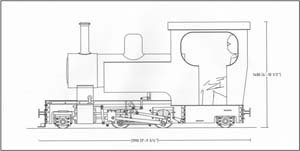
In this corner of the engine shed we are building a freelance 10 1/4″ narrow gauge tank locomotive to the “Priest” design by our member, Giles Favell. It has a 2-4-2 wheel arrangement.
Much of the early work was done by another of our members, Barry Metcalf, in his workshop but when he had to give this up he transferred the project to the Society. Since then progress has been slow but steady and various members have contributed by making and fitting parts. We have also had professional help from two engineering firms in Devon. Currently a boiler is being made by Bell Boilers of Gloucester.
The valve gear has been made and the necessary pins and bushes are being made by a member in his home workshop. Designs for the cylinders are being prepared and it’s intended to make a wooden mock-up of the superstructure over the next few months.
When completed we anticipate the loco will weigh about 1.50 tonnes and be capable of hauling our heaviest trains.
We have no firm ideas about the livery or name that the loco will carry. Visitors to the railway are invited to make suggestions about these. We will carefully consider all proposals in due course. If you’d also like to help with a small donation that would be very much appreciated.
The picture gives an idea of what the loco might look like.
Other locos
No.2 – Oddjob
“Hotpoint” Image Gallery
D1000
